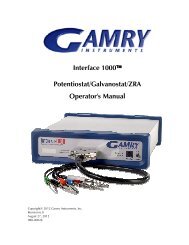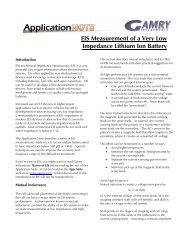Basics of Electrochemical Impedance Spectroscopy - Gamry ...
Basics of Electrochemical Impedance Spectroscopy - Gamry ...
Basics of Electrochemical Impedance Spectroscopy - Gamry ...
Create successful ePaper yourself
Turn your PDF publications into a flip-book with our unique Google optimized e-Paper software.
<strong>Electrochemical</strong> cells are not linear! Doubling the<br />
voltage will not necessarily double the current.<br />
However, Figure 6 shows how electrochemical systems<br />
can be pseudo-linear. If you look at a small enough<br />
portion <strong>of</strong> a cell's current versus voltage curve, it appears<br />
to be linear.<br />
Current<br />
Voltage<br />
Figure 6. Current versus Voltage Curve Showing<br />
Pseudo-Linearity<br />
In normal EIS practice, a small (1 to 10 mV) AC signal is<br />
applied to the cell. With such a small potential signal,<br />
the system is pseudo-linear. We don't see the cell's large<br />
nonlinear response to the DC potential because we only<br />
measure the cell current at the excitation frequency.<br />
If the system is non-linear, the current response will<br />
contain harmonics <strong>of</strong> the excitation frequency. A<br />
harmonic is a frequency equal to an integer multipled<br />
by the fundamental frequency. For example, the<br />
“second harmonic” is a frequency equal to two times<br />
the fundamental frequency.<br />
Some researchers have made use <strong>of</strong> this phenomenon.<br />
Linear systems should not generate harmonics, so the<br />
presence or absence <strong>of</strong> significant harmonic response<br />
allows one to determine the systems linearity. Other<br />
researchers have intentionally used larger amplitude<br />
excitation potentials. They use the harmonic response<br />
to estimate the curvature in the cell's current voltage<br />
curve.<br />
4<br />
Steady State Systems<br />
Measuring an EIS spectrum takes time (<strong>of</strong>ten many<br />
hours). The system being measured must be at a steady<br />
state throughout the time required to measure the EIS<br />
spectrum. A common cause <strong>of</strong> problems in EIS<br />
measurements and analysis is drift in the system being<br />
measured.<br />
In practice a steady state can be difficult to achieve.<br />
The cell can change through adsorption <strong>of</strong> solution<br />
impurities, growth <strong>of</strong> an oxide layer, build up <strong>of</strong> reaction<br />
products in solution, coating degradation, or<br />
temperature changes, to list just a few factors.<br />
Standard EIS analysis tools may give you wildly<br />
inaccurate results on a system that is not at steady state.<br />
Time and Frequency Domains and Transforms<br />
Signal processing theory refers to data representation<br />
domains. The same data can be represented in different<br />
domains. In EIS, we use two <strong>of</strong> these domains, the time<br />
domain and the frequency domain.<br />
In the time domain, signals are represented as signal<br />
amplitude versus time. Figure 7 demonstrates this for a<br />
signal consisting <strong>of</strong> two superimposed sine waves.<br />
Figure 7. Two Sine Waves in the Time Domain<br />
Figure 8 shows the same data in the frequency domain.<br />
The data is plotted as amplitude versus frequency.




